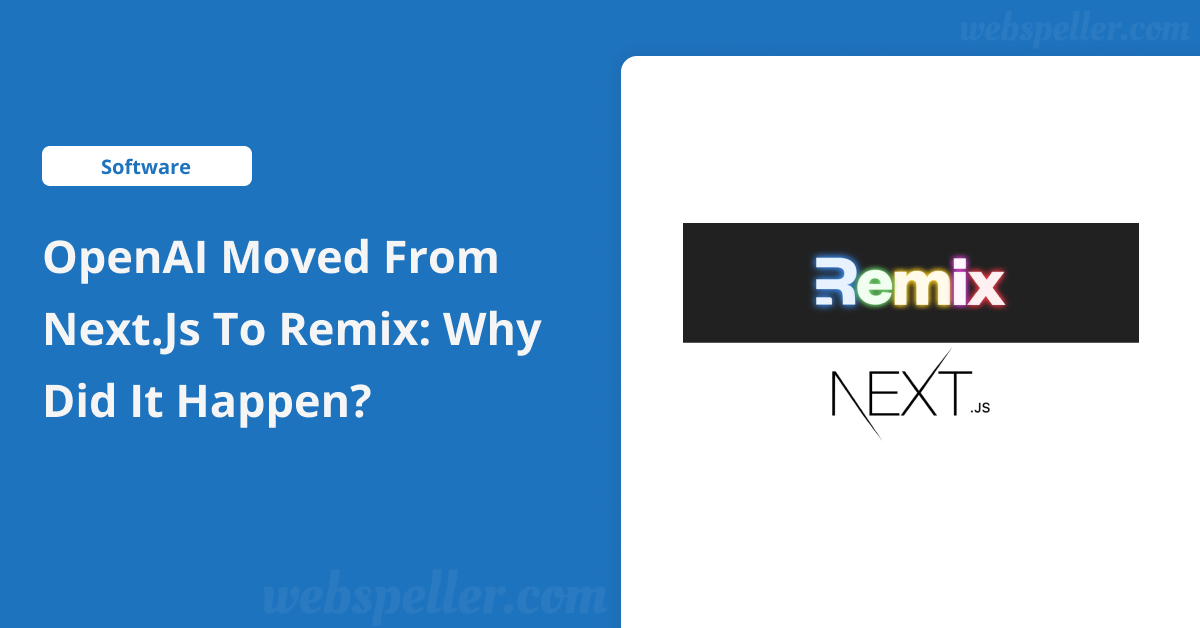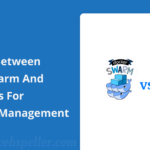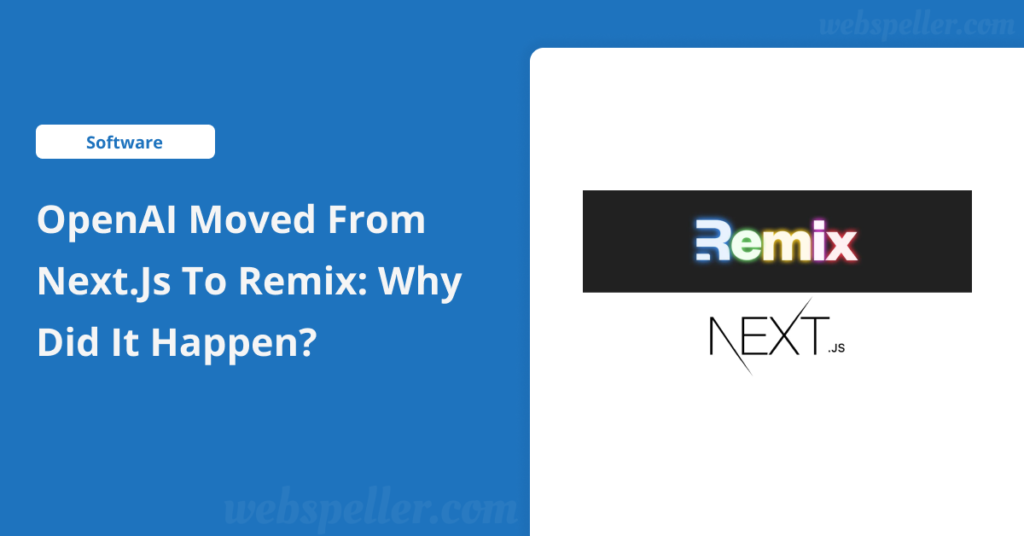
Table of Contents
Why OpenAI Switched to Remix: Key Reasons Behind the Transition

Recently, OpenAI made headlines with its decision to migrate from Next.js to Remix, causing widespread curiosity across the tech community. The announcement left many wondering about the reasons behind this shift, especially given Next.js’s widespread use in building server-side rendered React applications. In this article, we’ll explore why OpenAI moved from Next.js to Remix, based on key observations and technical factors.
From Next.js to Remix: OpenAI’s Bold Move Forward
Currently, ChatGPT uses client-side rendering, which is resource-intensive, with heavy JavaScript ops on the server. At the same time, Remix provides a balancing force for efficiency with its integrations of React Router for smoother client-side routing and rendering.
Client Rendering vs. Server Rendering
The OpenAI application is mostly based on client-side rendering, which puts most of the computational workload on the client’s web browser while limiting its dependence on server-rendered HTML.
Client-Side Rendering
Remix is efficient when it deals with client-side applications of this kind of situation. This means it ensures that for the users of OpenAI, the experience is fast and smooth.
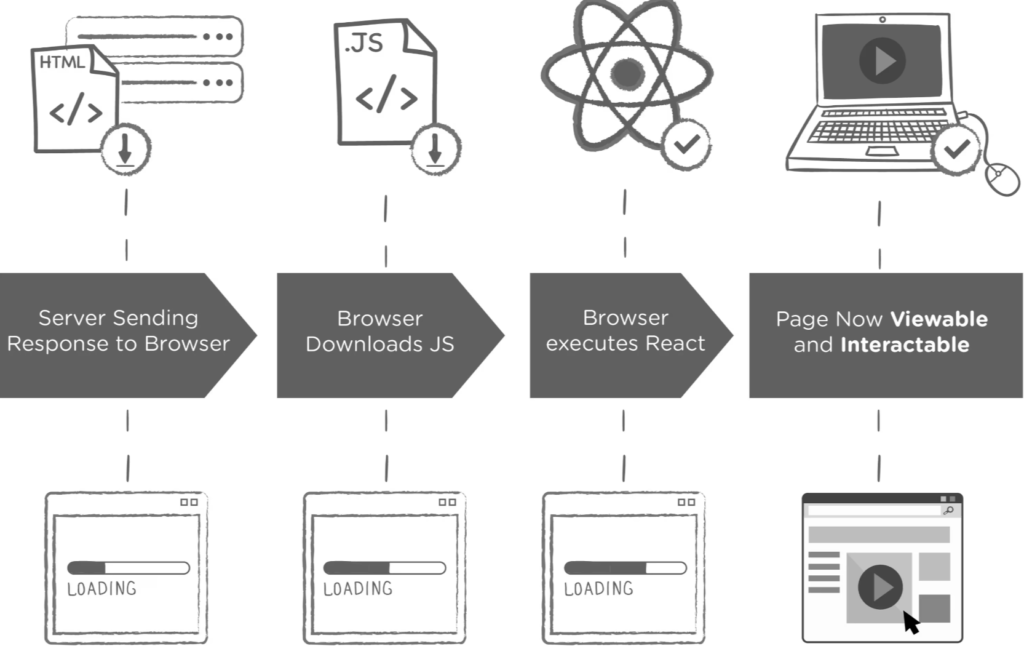
The Client-Rendered Focus of OpenAI’s Application
One of the primary reasons for OpenAI’s migration appears to be related to how their application functions. Contrary to the server-side rendering (SSR) focus of Next.js, OpenAI’s application is almost entirely client-rendered. This means that rather than the server generating HTML to send to the browser, most of the rendering happens on the client side. Remix is highly optimized for single-page applications (SPAs) like OpenAI’s, making it an ideal choice for their needs.
While Next.js excels at SSR, Remix offers flexibility for client-side rendering without unnecessary server-side overhead, aligning better with OpenAI’s approach. Remix also allows for smoother client-side navigation between pages, which is crucial for OpenAI’s interactive platform like ChatGPT, where users frequently switch between different pages and functionalities.
Efficient Data Loading with Remix Loaders
Remix’s ability to handle data efficiently was another key factor in the migration. Remix uses loaders to provide data to routes during the initial page render, eliminating the need to wait for additional API calls after the page loads. This approach is crucial for speeding up initial load times and ensuring that all necessary data is available from the start.
By using loaders, Remix allows OpenAI to pre-load all essential data—like user information, session tokens, and other crucial details—on the first page load. This not only improves performance but also enhances the user experience, as users are not left waiting for content to load after interacting with the application.
Optimized Routing System
Another significant advantage Remix offers is its routing system, which is built by the same team that created React Router. Remix’s routing is known for its flexibility and efficiency, especially for client-side applications. With around 60 different routes in OpenAI’s application, the robust routing capabilities of Remix likely played a pivotal role in their decision to switch.
While Next.js has powerful routing features, it is primarily designed with server-side rendering in mind. Remix, on the other hand, focuses on client-side navigation, allowing OpenAI to provide a seamless experience when users move between different sections of the platform.
Minimal Server-Side Rendering (SSR) Requirements
OpenAI’s platform doesn’t require heavy SSR or SEO optimization, which are areas where Next.js typically shines. Given that OpenAI’s core functionalities revolve around an API-driven architecture, the need for server-rendered HTML is minimal. Remix’s approach to hydration—the process of delivering the necessary data to the client for rendering—works perfectly in this scenario. The server only needs to provide the essential data, and Remix handles the rest client-side.
The Power of Vite Over Webpack
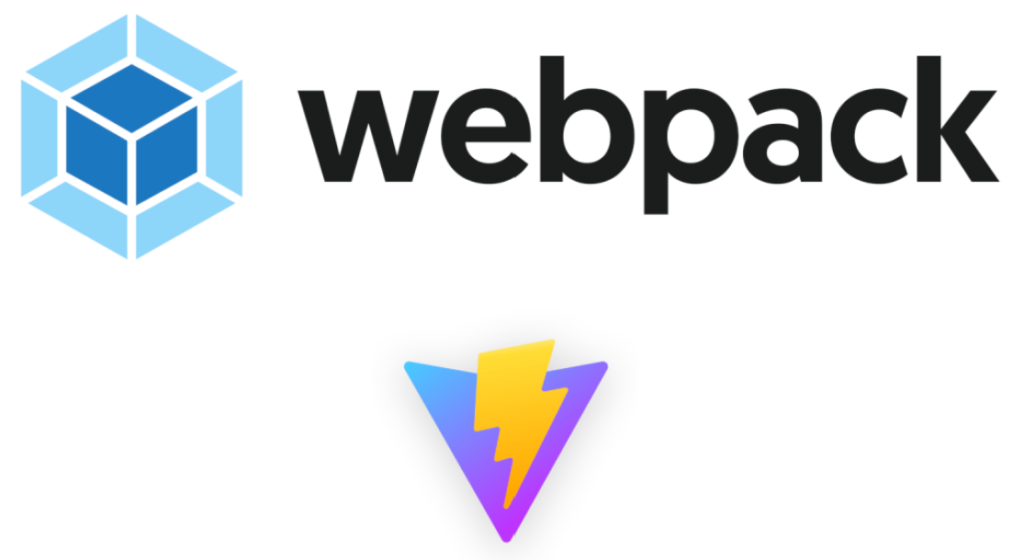
Another noteworthy change with Remix is its use of Vite, a modern build tool that offers faster builds and a more efficient development experience compared to Webpack, which powers Next.js. Vite’s lightweight nature makes it easier for developers to manage and optimize their applications, which is critical for large-scale projects like OpenAI.
While Next.js has been developing TurboPack, its own build tool, to improve performance, the flexibility and speed of Vite make it an attractive option for OpenAI’s needs.
Integration with Existing Infrastructure
OpenAI’s tech stack involves complex backend APIs, separate from the front-end rendering. Remix’s ability to integrate with APIs seamlessly aligns with OpenAI’s infrastructure, where the backend processes and APIs handle most of the heavy lifting. In this architecture, Remix’s role is to manage the front-end efficiently, allowing OpenAI’s servers and APIs to function independently.
Moreover, Remix runs on Express servers, which are lightweight and efficient, and uses Azure CDN for content delivery. These factors further highlight why OpenAI decided to migrate from Next.js to Remix, as Remix’s server infrastructure complements OpenAI’s architecture.
Conclusion: Why OpenAI Made the Move
The decision for OpenAI to move from Next.js to Remix ultimately boils down to several factors: a client-rendered approach, efficient data loading via loaders, a robust routing system, minimal SSR requirements, and the power of Vite over Webpack. For OpenAI, which operates a highly dynamic and interactive platform, Remix provides the flexibility and performance needed to deliver a smooth user experience.
While Next.js remains a powerful framework for server-side rendering, Remix offers the right tools and architecture for applications like OpenAI’s that prioritize client-side interactions and seamless API integration. This migration highlights the growing trend of companies optimizing their tech stacks based on their specific needs rather than following conventional choices.
FAQ About Why OpenAI switched from Next.JS to Remix?
Why did OpenAI move from Next.js to Remix?
OpenAI moved to Remix for better client-side rendering, efficient data handling, and a more flexible routing system.
What is the main difference between Next.js and Remix in this context?
Next.js focuses on server-side rendering, while Remix is optimized for client-side rendering, which aligns better with OpenAI’s architecture.
How does Remix improve performance for OpenAI’s application?
Remix uses loaders to preload data, ensuring faster initial load times and smoother client-side navigation.
What role does the routing system play in OpenAI’s move to Remix?
Remix’s robust routing system, built on React Router, is better suited for client-side applications like OpenAI’s, offering more flexibility.
Is server-side rendering (SSR) still used in OpenAI’s application after the move?
Minimal SSR is used. Most of the rendering happens client-side, which is more efficient for OpenAI’s needs.
What build tool does Remix use, and how is it better than Next.js’s Webpack?
Remix uses Vite, a faster and more lightweight tool compared to Webpack, which powers Next.js.
Does Remix improve SEO for OpenAI?
SEO is not a primary concern for OpenAI’s application, as it focuses more on client-side interactions and API-driven content.
What infrastructure changes did OpenAI make after moving to Remix?
OpenAI now runs its Remix application on Express servers and uses Azure CDN for content delivery, complementing its backend API architecture.
Does Remix handle API integration better than Next.js?
Remix seamlessly integrates with APIs, making it ideal for OpenAI’s architecture, where the backend handles heavy processing.
Will OpenAI continue to use Next.js for any of its other applications?
While OpenAI moved this application to Remix, they may still use Next.js for projects that require server-side rendering.
